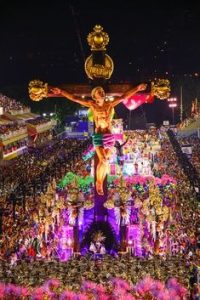The Devil’s Parade

I confess, I am not a true follower of the Rio carnival—too many people, too late at night until too early in the morning, too loud, and too long. At most, I watch the highlights on TV. I do appreciate, however, the enormous effort that activists put into preparing the whole year for the great parade.
The roots of the Samba Schools are in the communities we used to call favelas, poor and perilous, but also highly creative. The carnival is a time when persons who are incidentally or deliberately overlooked—deemed as insignificant by the wider public or simply seen as “bandits,” “vagabonds,” and “marginals”—come to the fore and are seen. They shine on the Marques do Sapucaí, where the famous parade of the Special Group takes place and competes for the longed-for trophy. They dance, they sing, they play, they show joy and pride—over three thousand of them for each School.
As a theologian, I take special interest in those groups that feature some kind of religious element. There are many. In 2020, for example, Estação Primeira de Mangueira sang that “the truth will make you free.” As I explain in my contribution to Public Theology in Brazil and South Africa – a Political-Theological Dialogue, the title of the theme song evokes the passage from the Gospel of John 8:32: “You will know the truth, and the truth will make you free.” This verse also served as a motto for former Brazilian president, Jair Messias Bolsonaro, who understood himself as performing a divine mission. The “truth,” apparently, conformed to what he published on Twitter, was a “truth” often contested by the media.
The biblical text itself, as well as the Samba School’s use of it goes, however, in quite another direction. Indeed, the School opposed Bolsonaro’s idea of truth and reality. It criticized his politics, insensitive as it was to minorities, diversity, and poverty, making frequent use of fake news propagated as “truth.” To this end, the Samba School employed irony, estrangement, and enthusiasm for an alternative worldview. This is carnival at its best, I dare say.
The main figure of one of the School’s floats was a crucified young African Brazilian boy with peroxided, shining blond hair. Indeed, the main victims of daily lethal violence are persons of color, young, male, and poor. The boy’s peroxided hair seems to be a way to emerge from invisibility at least once in a lifetime. Columnist Leonardo Sakamoto notes: “When daily life is absurd, truth lies with Carnival . . . the Truth is that Christ dies, day after day, saintly or profane, through the genocide of black youth at the cities’ peripheries.”
Obviously, the portrayal of a slum boy as the crucified Christ aroused criticism among those Christians who hold to the image of a pure, angelic, white Christ to be preserved from any worldly connotation. Such rejection was even stronger when transgender Viviane Beleboni represented the crucified Christ at the 2015 LGBTQ+ Pride Parade in São Paulo, showing her bare breasts.
It is apparently not easy to recognize that the crucified Christ not only represents a vulnerable and caring God to humanity but also exposes human violence against all its victims, whose faces are mirrored in Jesus of Nazareth on the cross. Viviane represented a much truer Christ and, indeed, a true humanity on the cross. Carnival’s irony brought, it may seem to me, greater truth than its critics, even in relation to matters of faith.
Verbal and sometimes even physical attacks by some Christians on members of the LGBTQ+ communities, on women, on people of color, and on people of “other,” namely African-originated faiths are, sadly, a daily feature in Brazil. Should there, on the grounds of Jesus’ example and teaching, not rather be a sense of shame in view of such violence and intolerance?
The Schools are a form of public theology that throws itself, in the midst of Carnival, into the parade to challenge everyone’s tranquility. It puts a mirror in front of society and of the presently strong presence of religion in the political arena—a mirror that functions through irony, estrangement, and alternative enthusiasm.
At this year’s Rio Carnival, it was the turn of the Samba School Academicos do Salgueiro to play with religion. Its theme was “Delirium of a Red Paradise,” which featured both Jesus and the Devil, angels and demons, the red apple of original sin and the “delirium” of the red-colored School celebrating itself. The School as “religion” and references to Christianity and other religions intermingle. Hybridity looms large.
They sang:
Who will be a sinner?
Who will point their finger?
There is a look of wanting to judge
if everyone has their own way
It is better to live together without prejudice . . .
Blessed redemption
The excluded freeing their pain
Embarking on the rebirth of their values
Enough of violence and oppression
Enough of intolerance
The light of eternity lights the flame
Celebrating equality
That happiness emanates.
This is a protest against intolerance, fundamentalism, and the restriction of freedom and, as they see it, of happiness. If this is already difficult for some Christians to stomach, one of Salgueiro’s floats featured a huge devil. There was a considerable uproar. It was considered an offense to the Christian faith, a “profanation” of the most serious battle of God vs. the devil. Indeed, Carnival is ironic and irreverent. The devil’s parade was meant to be a critique of an exacerbated moralistic agenda, held by many, mainly white, right-wing evangelicals and Catholics in Brazil and seen as repressive rather than liberating.
The devil’s parade points to the excluded who are, in church as in society, more often than not severely judged and punished for their transgression of practices that are deemed “decent.” Through provoking indecency, the excluded whom we saw shining on the Sapucaí understand God to be on their side, not only during the Carnival but also beyond. The devil’s parade is, I believe, a healthy reminder that they are there—and that God might actually be with them rather than with their critics.
#
Rudolf von Sinner, Swiss by origin and naturalized Brazilian, is a Lutheran theologian and pastor. He teaches at the Pontifícia Universidade Católica do Paraná in Curitiba, Brazil, where he heads the Graduate Program in Theology. He is also an extraordinary professor at the University of Stellenbosch, South Africa, and currently the chair of the Global Network of Public Theology. A prolific writer and speaker, among his books are The Churches and Democracy in Brazil and Public Theology in the Secular State.
Counterpoint would like to thank our Guest Editor, Dion Forster (University of Stellenbosch; see also here), for curating this blog, the second in a series of four.
Counterpoint blogs may be reprinted with the following acknowledgement: “This article was published by Counterpoint: Navigating Knowledge on 29 March 2023.” The views and opinions expressed on this website, in its publications, and in comments made in response to the site and publications are those of the author(s) and do not necessarily reflect the views and opinions of Counterpoint: Navigating Knowledge, its founders, its staff, or any agent or institution affiliated with it, nor those of the institution(s) with which the author is affiliated. Counterpoint exists to promote vigorous debate within and across knowledge systems and therefore publishes a wide variety of views and opinions in the interests of open conversation and dialogue
Photo Image: A Black Jesus displayed by the Mangueira Samba Community during Carnaval of 2020. Photo: Viviane Medina/Riotur



